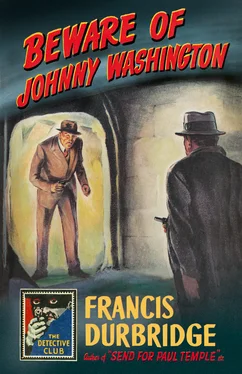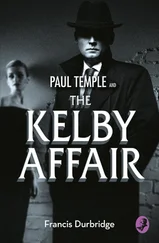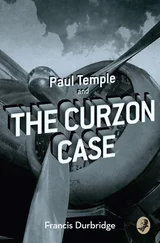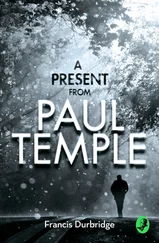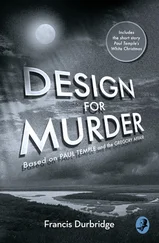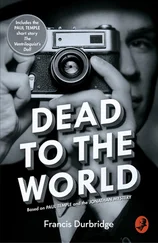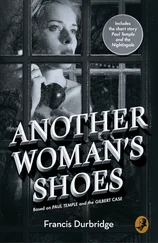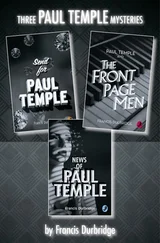‘THE DETECTIVE STORY CLUB is a clearing house for the best detective and mystery stories chosen for you by a select committee of experts. Only the most ingenious crime stories will be published under the THE DETECTIVE STORY CLUB imprint. A special distinguishing stamp appears on the wrapper and title page of every THE DETECTIVE STORY CLUB book—the Man with the Gun. Always look for the Man with the Gun when buying a Crime book.’
Wm. Collins Sons & Co. Ltd., 1929
Now the Man with the Gun is back in this series of COLLINS CRIME CLUB reprints, and with him the chance to experience the classic books that influenced the Golden Age of crime fiction.
COLLINS CRIME CLUB
An imprint of HarperCollins Publishers Ltd
1 London Bridge Street
London SE1 9GF
www.harpercollins.co.uk
First published in Great Britain by John Long Ltd 1951
'A Present for Paul' first published by the Yorkshire Evening Post 1946
Copyright © Estate of Francis Durbridge 1946, 1951
Introduction © Melvyn Barnes 2017
Jacket layout design © HarperCollins Publishers Ltd 2017
A catalogue copy of this book is available from the British Library.
This novel is entirely a work of fiction. The names, characters and incidents portrayed in it are the work of the author’s imagination. Any resemblance to actual persons, living or dead, events or localities is entirely coincidental.
All rights reserved under International and Pan-American Copyright Conventions. By payment of the required fees, you have been granted the non-exclusive, non-transferable right to access and read the text of this e-book on screen. No part of this text may be reproduced, transmitted, down-loaded, decompiled, reverse engineered, or stored in or introduced into any information storage and retrieval system, in any form or by any means, whether electronic or mechanical, now known or hereinafter invented, without the express written permission of HarperCollins.
Source ISBN: 9780008242053
Ebook Edition © October 2017 ISBN: 9780008242046
Version: 2017-09-07
Contents
Cover
Title Page
Copyright
Introduction
I. AN OBVIOUS CLUE
II. ENTER JOHNNY WASHINGTON
III. GREY MOOSE
IV. A JOB FOR THE POLICE
V. INQUISITIVE LADY
VI. A PRELIMINARY CONFERENCE
VII. A CALL FROM SCOTLAND YARD
VIII. LONDON BY THE SEA
IX. TALK OFF THE RECORD
X. RENDEZVOUS
XI. WHAT’S YOUR POISON?
XII. JOHNNY MAKES A SUGGESTION
XIII. AN UNEXPECTED PRESENT
XIV. A STRAIGHT TIP
XV. AN INFORMAL VISIT
XVI. BEHIND THE PANEL
XVII. THE SECRET TUNNEL
XVIII. ‘THE BEST LAID PLANS …’
XIX. A CASE OF ABDUCTION?
XX. EXIT VERITY GLYN?
XXI. MR QUINCE HAD A CLUE
XXII. THE ENEMY CAMP
XXIII. RUN TO EARTH
XXIV. THE DESERTED CAR
XXV. ‘RELEASE AT DAWN’
XXVI. THE END OF GREY MOOSE
POSTSCRIPT: A PRESENT FOR PAUL
The Detective Story Club
About the Publisher
FRANCIS Henry Durbridge (1912–1998) was arguably the most popular writer of mystery thrillers for BBC radio and television from the 1930s to the 1970s, after which he enjoyed a successful career as a stage dramatist. His radio serials are regularly repeated today, while his stage plays remain among the staple fare of amateur and professional theatre companies.
He was born in Kingston upon Hull and educated at Bradford Grammar School, Wylde Green College and Birmingham University, and as an undergraduate he began to pursue his schoolboy ambition to become a writer. Although he later worked briefly in a stockbroker’s office, his career as a full-time writer was assured by the BBC in the early 1930s when he responded to the broadcaster’s voracious appetite by providing comedy plays, children’s stories, musical libretti and numerous short sketches.
It was nevertheless his first two serious radio dramas, Promotion and Murder in the Midlands , that showed the sort of scriptwriting he particularly favoured. In 1938, at the age of twenty-five, he established himself in the crime fiction field when the BBC broadcast his serial Send for Paul Temple . Listeners ecstatically submitted over 7,000 requests for more, no doubt finding his light touch and characteristic ‘cliff-hangers’ a welcome distraction from worries about the gathering storm in Europe. Almost immediately Durbridge became one of the foremost writers of radio thrillers, with a prolific output that he further expanded by sometimes using the pseudonyms Frank Cromwell, Nicholas Vane and Lewis Middleton Harvey. To place him in context, in the mid-twentieth century his closest comparators were Edward J. Mason and Lester Powell (both coincidentally born the same year as Durbridge), together with Ernest Dudley, Alan Stranks and Philip Levene.
Send for Paul Temple was broadcast in eight episodes from 8 April to 27 May 1938. In this first case for the novelist-detective he meets newspaper reporter Steve Trent, who tells him that she has changed her name from Louise Harvey in order to pursue a gang of jewel thieves. The murder of her brother, a Scotland Yard man, unites Temple and Steve in their determination to unmask the Knave of Diamonds. That achieved, they create crime fiction history by deciding to marry—thus securing a quick return to the airwaves in Paul Temple and the Front Page Men in the autumn of 1938 and thereafter cementing their position as a mainstay of the BBC.
The early Paul Temple radio serials were adapted as books from the outset, but Durbridge’s first five novelisations were collaborations with another author because at that time he regarded himself as essentially a writer of dialogue, a scriptwriter rather than a novelist. Send for Paul Temple was published by John Long in June 1938, so it was presumably written while the radio serial was being broadcast and was intended to capitalise on the serial’s success. It was described in newspaper advertisements at the time as ‘the novel of the thriller that created a BBC fan-mail record’, and it was made Book of the Month by the Crime Book Society. The co-author was identified as John Thewes, although today it is widely believed that this was a pseudonym of Charles Hatton (who used his own name when collaborating on the next four Paul Temple novels). There is further evidence that Durbridge saw the wider potential of Send for Paul Temple , because he adapted it as a stage play produced in Birmingham in 1943 and also co-wrote the screenplay of the 1946 film version.
The Paul Temple serials proved to be Durbridge’s most enduring work for the radio, and they continued until 1968. One could easily assume that in the twenty-first century they might be regarded as passé , but today the Temples have been re-introduced to radio listeners through repeats of the surviving original recordings and new productions of the ‘lost’ serials, and there is a continuing market in printed books, e-books, CDs, DVDs and downloads. A new generation, together with those feeling nostalgic, can follow the exploits of the urbane detective who is constantly faced with bombs concealed in packages or booby-trapped ‘radiograms’, who deplores violence except in self-defence, and who never uses bad language but regularly utters the oath ‘By Timothy!’ The appeal seems undiminished, irrespective of the fact that the Durbridge milieu of Thames houseboats, expensive apartments, luxury sports cars and sophisticated cocktails must surely be alien to the lives of many among his present day audience.
The Temples were by no means the only protagonists created for radio audiences by Francis Durbridge. Among others was Johnny Washington, who appeared in eight episodes from 12 August to 30 September 1949 entitled Johnny Washington Esquire . This was not a serial, but a run of complete thirty-minute plays described as ‘the adventures of a gentleman of leisure’, with a young American scoring barely legal coups in Robin Hood style at the expense of London underworld characters. Of particular interest was the fact that Johnny was played by the Canadian actor Bernard Braden, who before his move to the UK had played the title role in the Canadian radio version of Send for Paul Temple in 1940.
Читать дальше
